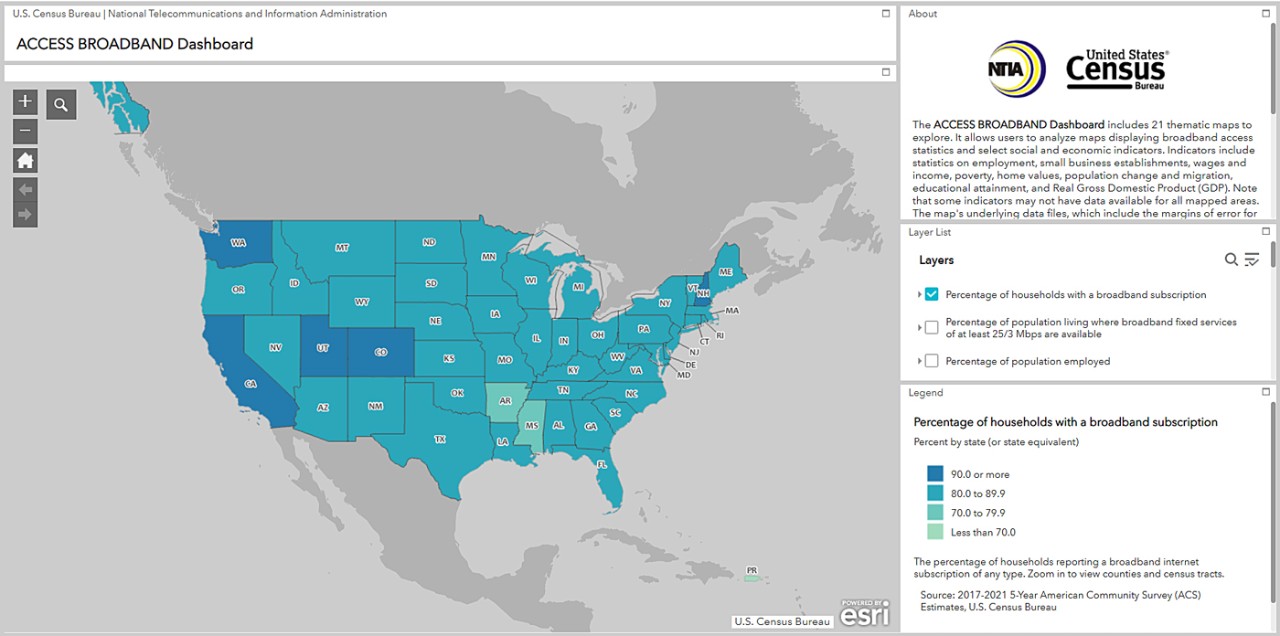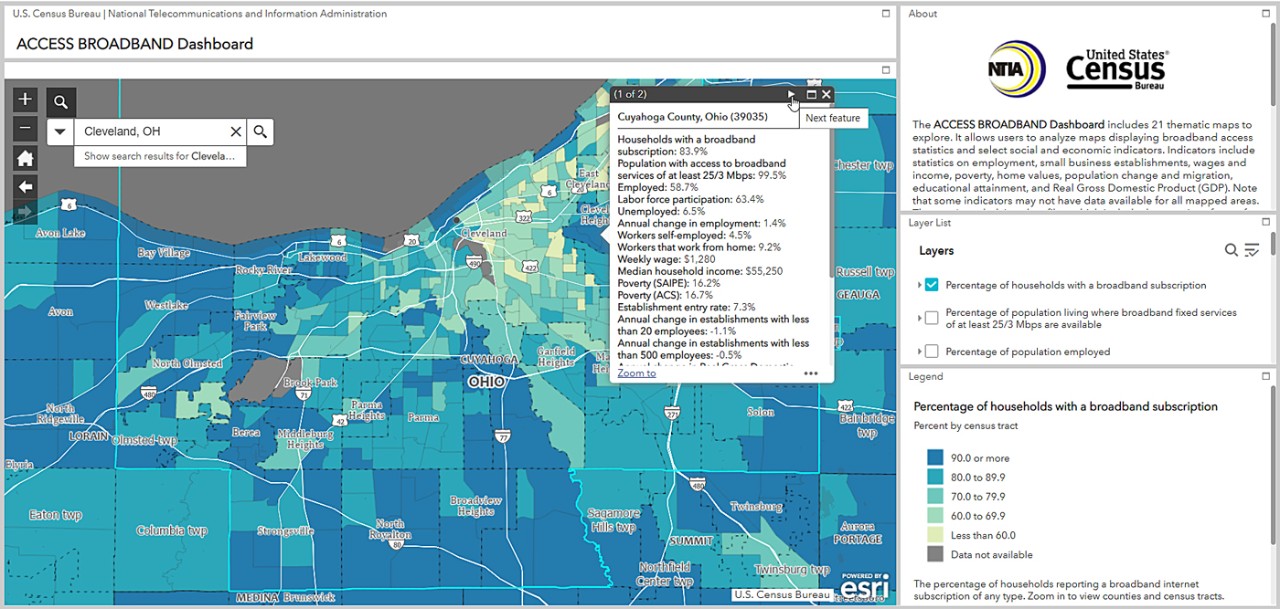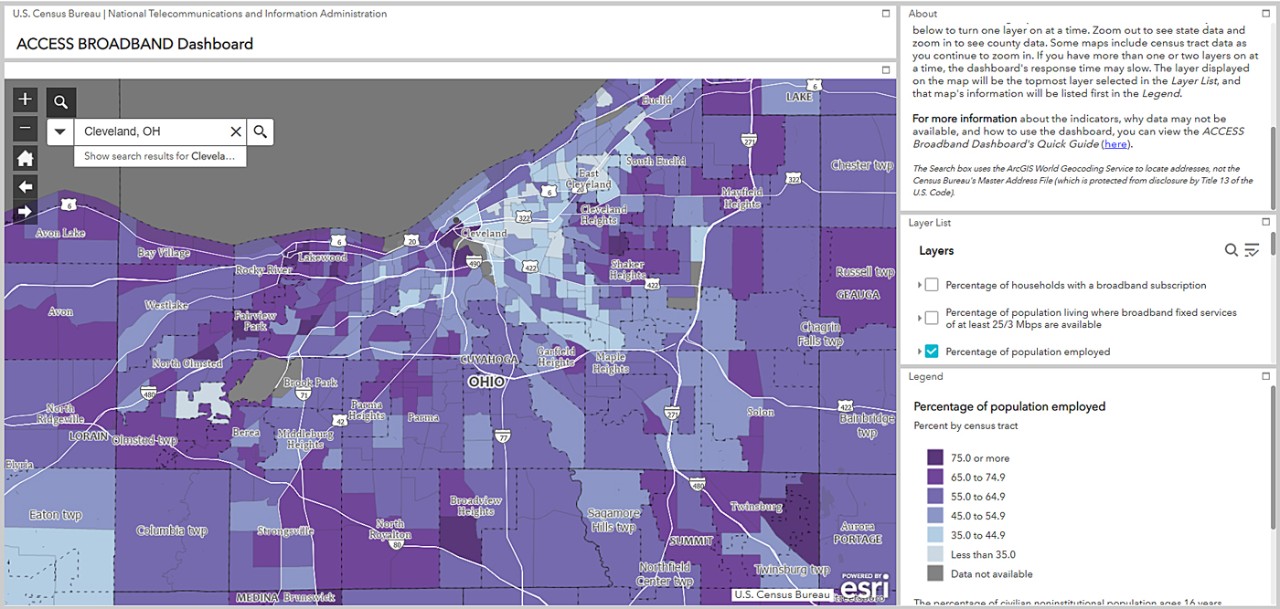New ACCESS BROADBAND Dashboard Helps Assess How Broadband Availability and Adoption Impact Local Economies
Who has access to broadband in your community? What is the demographic and economic profile of the communities that don’t? How could investments in broadband infrastructure impact your local economy?
As part of the Consolidated Appropriations Act of 2021, the ACCESS BROADBAND Act of 2021 charged the National Telecommunications and Information Administration (NTIA) with tracking federal broadband investment. The legislation requires NTIA to report on the economic impact of federal broadband investments on local economies, including any effect on small businesses or jobs.
The NTIA has been working with the U.S. Census Bureau to develop the ACCESS BROADBAND Dashboard as part of this effort.
The dashboard includes a series of maps showing different broadband access measures as well as economic characteristics that research suggests could be influenced by increased access to broadband.
The dashboard is designed to help policymakers and the public assess how changes in broadband availability and adoption could impact local economies.
The interactive dashboard includes a series of maps displaying statistics on broadband access as well as select social and economic characteristics. All maps are available for U.S. states, the District of Columbia, and counties. A few are available at the census tract level. Most maps also include statistics for Puerto Rico.
This first release of the ACCESS BROADBAND Dashboard enables users to assess baseline economic characteristics at the smallest geographic level possible.
The NTIA and Census Bureau plan to update the dashboard annually which will allow users to assess the economic impact on areas where broadband availability and adoption efforts are underway.
Each release will include the interactive dashboard and supplemental data files so users can access the underlying map data.
ACCESS BROADBAND Dashboard
The dashboard includes a series of maps showing different broadband access measures as well as economic characteristics that research suggests could be influenced by increased access to broadband.
The 21 maps included in the ACCESS BROADBAND Dashboard show the:
- Percentage of households with a broadband subscription.
- Percentage of population living where broadband fixed services of at least 25/3 Mbps are available.
- Percentage of population employed.
- Labor force participation rate.
- Unemployment rate.
- Annual change in employment.
- Percentage of workers self-employed.
- Percentage of workers that work from home.
- Average weekly wage (dollars).
- Median household income (dollars).
- Poverty rate (Census Bureau’s Small Area Income and Poverty Estimates or SAIPE).
- Poverty rate (American Community Survey or ACS).
- Establishment entry rate.
- Annual change in business establishments with less than 20 employees.
- Annual change in business establishments with less than 500 employees.
- Annual change in real Gross Domestic Product (GDP).
- Median home value (dollars).
- Annual change in population.
- Net migration rate.
- Percentage of population with a bachelor's degree or higher.
- Percentage of high school-aged population that did not graduate and are not enrolled in school.
The maps’ data come from the Census Bureau and other federal agencies, including the Federal Communications Commission, Bureau of Labor Statistics and Bureau of Economic Analysis. More details on how these estimates were generated are available in the Technical Specification.
The data, which include the margins of error for estimates derived from survey data, are available for download, in the ACCESS BROADBAND Dashboard's data files.
Interact with the live application by clicking on the map below.
Exploring the Maps
The dashboard was designed for users to examine an area’s broadband availability and adoption statistics and gain an understanding of the area’s economic conditions.
This can be done two ways: By clicking or tapping on the map to reveal the selected geographic entity’s characteristics in a pop-up window or by toggling between map layers to compare maps.
How would someone interested in evaluating the area around Cleveland, Ohio, use both methods?
One way is by clicking the map to reveal pop-ups.
The user selects the map layer for the “Percentage of households with a broadband subscription” and zooms in to the Cleveland, Ohio, area to see a census tract level map.
When hovering a mouse over a geographic area, a pop-up will appear with statistics from all 21 map layers. In this case the user will see statistics for Cuyahoga County, Ohio, where Cleveland is located. By clicking the next feature in the pop-up header, they can also see available statistics for census tracts.
Another way is by comparing map layers.
In this example, the user wants to see how the map layer for broadband subscriber compares to the layer for the “Percentage of population employed.” They can observe data across communities by toggling back and forth between the two maps.
More information on how to use the dashboard to explore your local area is available in the dashboard tutorial.
We encourage you to explore your community and think about how having or not having access to the internet may impact your local economy.
For more information on these tools, email Bethany.DeSalvo@census.gov.
Subscribe
Our email newsletter is sent out on the day we publish a story. Get an alert directly in your inbox to read, share and blog about our newest stories.
Contact our Public Information Office for media inquiries or interviews.










